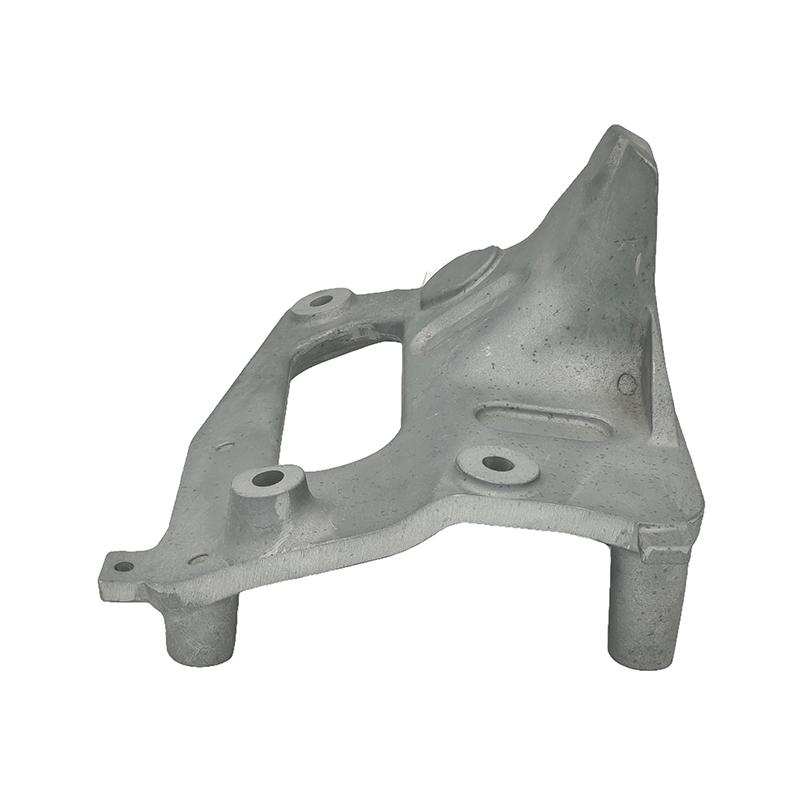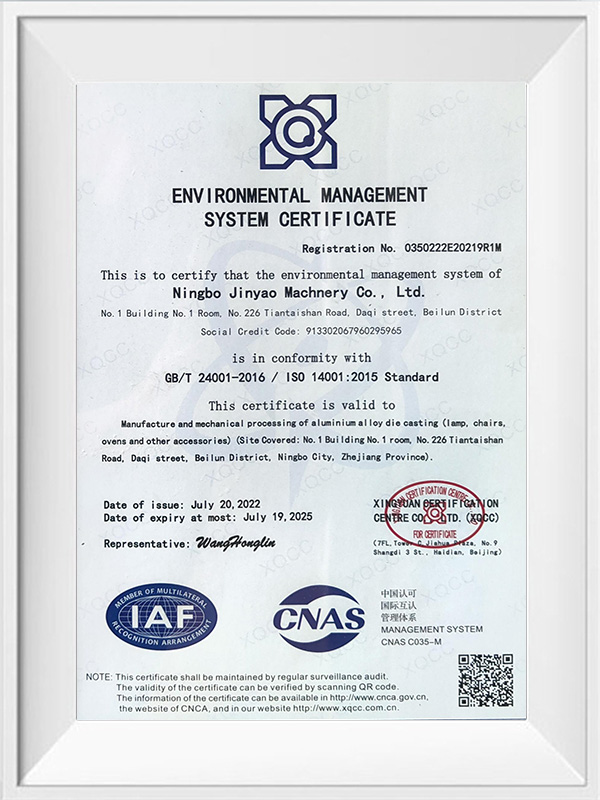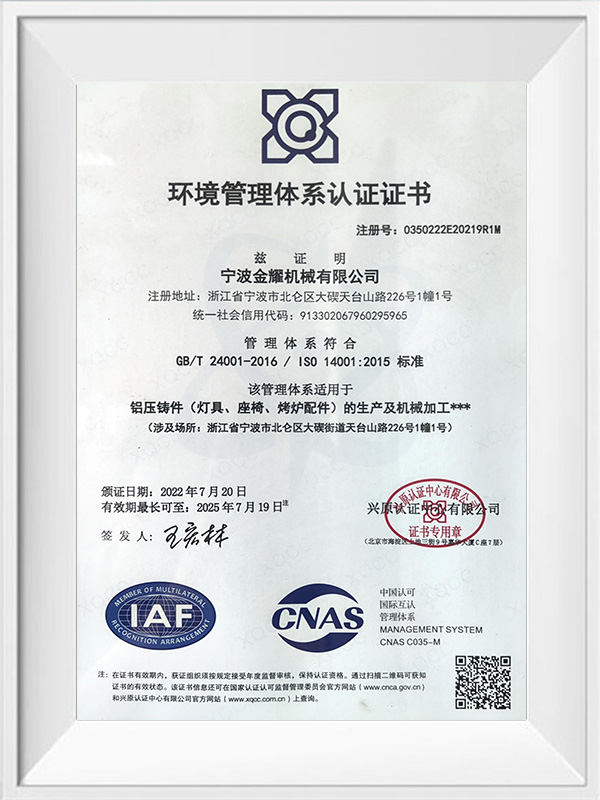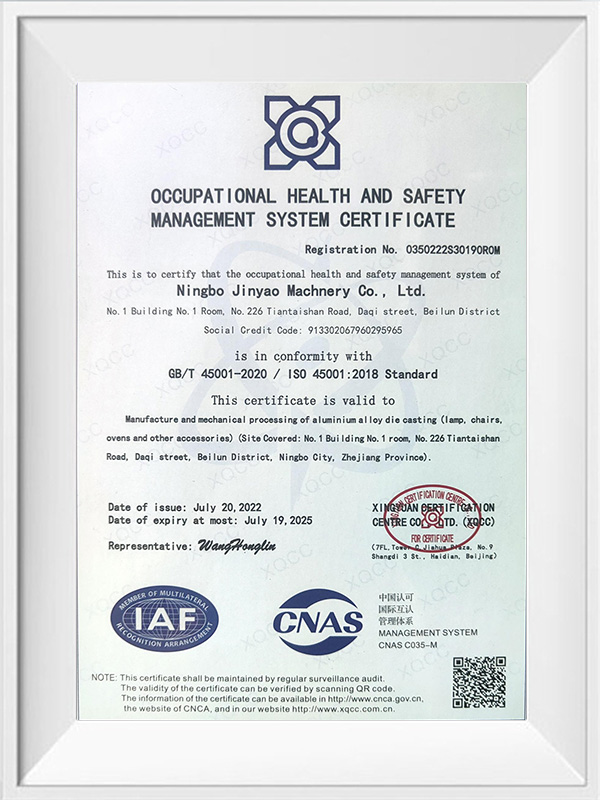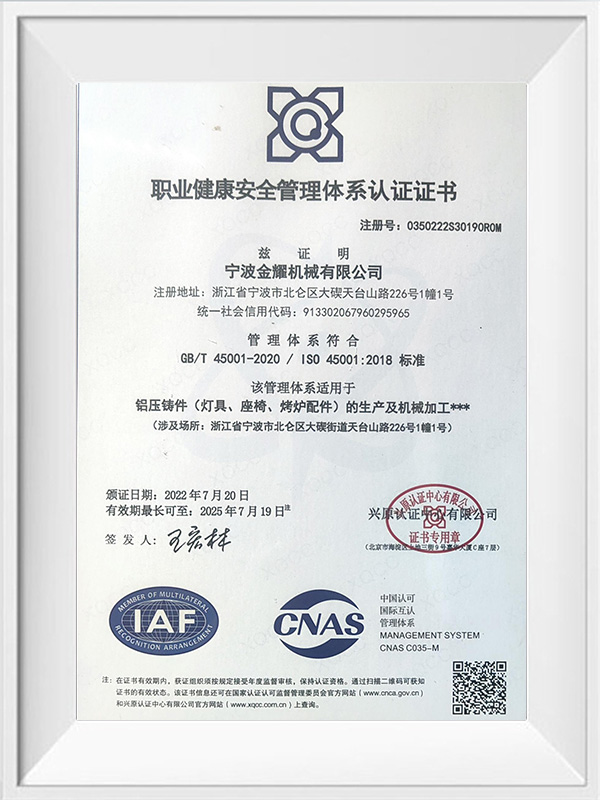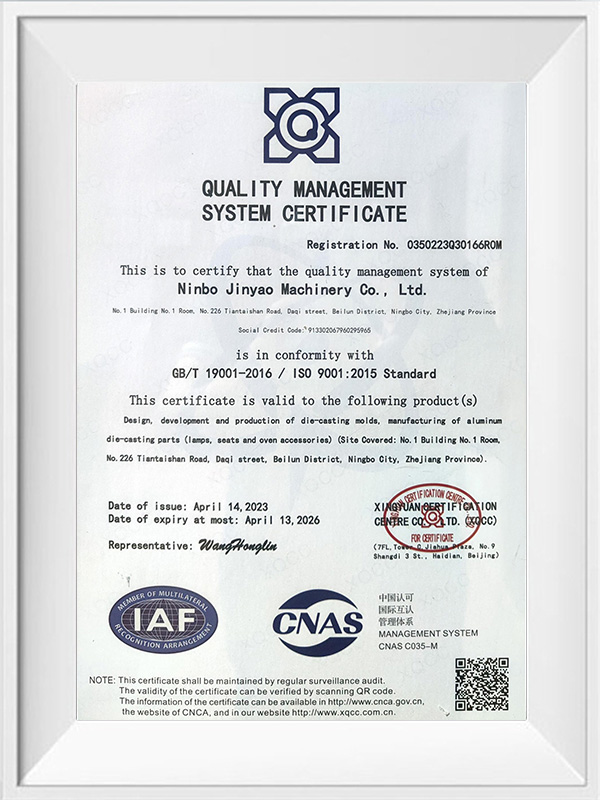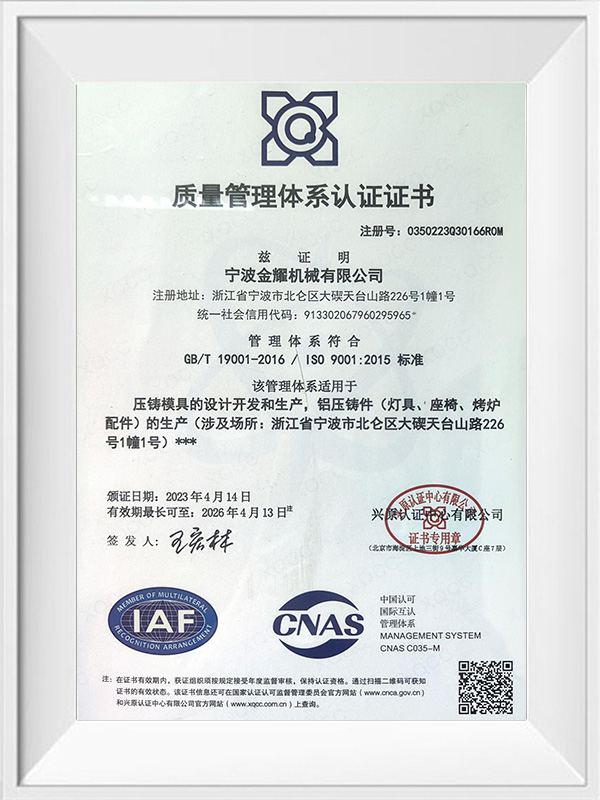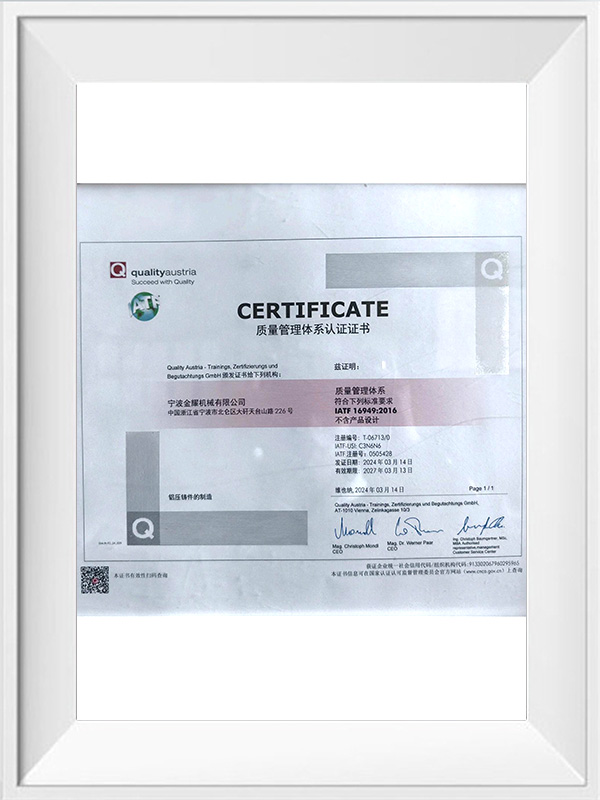Ningbo Jinyao Machinery Co., Ltd. is a China Engine bracket die castings Suppliers and Engine bracket die castings Foundry . And is an enterprise integrating industry and trade, dedicated to the production of precision castings of aluminum alloy materials and the design and manufacture of high-pressure die-casting molds. Adopting advanced vacuuming, pin extrusion, and high-pressure spot cooling processes, it is a large-scale professional production base for diversified casting in China. It integrates a precision casting factory and a mechanical processing plant, and can produce precision castings and various types of castings annually. More than 10,000 tons, mainly exported to Japan, Sweden and other countries. Among the customers we cooperate with are many OEM customers of trains, cars, forklifts, outboards, communication equipment, lamps, furniture parts and engineering machinery, including the world's top 500 companies. , has become an important supplier of their precision castings in China.
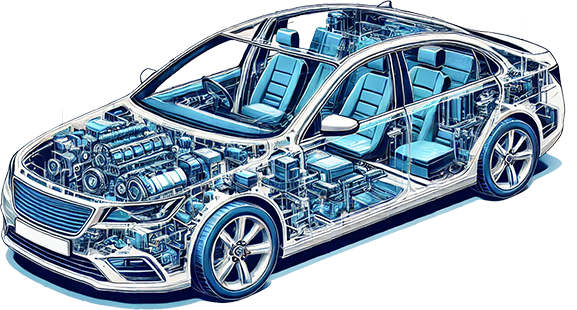
Engine bracket die castings Suppliers
- Traditional automobile die castings
- New energy automobile die castings
- Communication housing die castings
- Electric scooter die castings
- Bicycle power motor die castings
- Motorcycle accessories die castings
- Motor housing die castings
- Engineering machinery die castings
- Lighting die castings
- Outboard motor die castings
- Furniture accessories die castings
- Grill accessories die casting
- Photovoltaic inverter die castings
The die-casting engine bracket is an important part of the automobile engine suspension system. It mainly connects the engine and the vibration reduction element. During the operation of the vehicle, it usually needs to withstand road impact and engine vibration. Therefore, it has high requirements for its mechanical properties and needs to have sufficient strength, rigidity, and service life.
Its material is generally aluminum alloy, etc. The engine bracket die casting produced by the die casting process has the advantages of precise size, mechanical properties, dense internal structure, etc., and can be mass-produced.
However, during the casting process, due to the uneven wall thickness and complex structure of the engine bracket, it is easy to produce defects such as shrinkage and shrinkage holes, which will affect the strength and rigidity and endanger the driving safety of the car. In order to improve the comprehensive yield rate of die-casting parts of the engine bracket, die-casting process design is usually carried out, and numerical simulation is performed using relevant software to analyze the location and cause of possible defects, and then the process is improved and optimized to avoid the occurrence of casting defects.
For example, the die-casting process design of the engine bracket die-casting made of aluminum alloy includes the selection of parting surface, ingates design, cross runner design, etc. When selecting the parting surface, the plane where the projected area is located will be selected as the parting surface according to the structure of the casting; the design of the position of the ingates needs to consider making the metal liquid flow as short as possible to reduce heat loss and avoid direct impact on the core; the structural form of the cross runner depends on the shape, position, direction and size of the ingates, and its thickness also has a corresponding calculation method and a certain draft angle will be set for easy demoulding.
In short, the quality of engine bracket die castings is crucial to the performance and safety of the car, and its manufacturing process needs to be carefully designed and strictly controlled to ensure that all requirements are met. Engine bracket die castings made of different materials and processes may vary in performance and characteristics. The specific design and manufacturing will be adjusted and optimized according to factors such as the type of car, performance requirements, and the technical level of the manufacturer.
-
What is Anodized Aluminum Die Casting and How Does It Work?View More
Anodized aluminum die casting is a highly efficient manufacturing process that combines two distinct techniques—die casting and anodizing—into one to create parts that are both highly durable and visually appealing. This process is particularly beneficial for industries that require components with ...

-
How Does Die Casting Surface Treatment Improve Product Durability?View More
Die casting is one of the most widely used metal manufacturing processes, providing high precision, complex shapes, and efficiency. However, raw die-cast components often face challenges such as corrosion, wear, surface defects, and reduced longevity. Implementing proper die casting surface treatme...

-
What Are the Common Defects Found in Die Casting Molds and How Can They Be Prevented?View More
Die casting is a popular and efficient manufacturing process for producing high-precision metal parts. It is widely used across many industries such as automotive, aerospace, and electronics. Like any manufacturing process, die casting is prone to defects, which can negatively affect part quality, p...

Overview and Importance of Engine Bracket Die Castings
Engine Bracket Die Castings are metal parts manufactured by die casting, mainly used to support and fix engines and related parts. Since the engine needs to withstand high temperature, vibration, impact and other extreme working conditions, bracket castings need to have excellent strength, stability and durability.
Most of these castings are made of aluminum alloy, magnesium alloy, zinc alloy and other materials. These materials are not only light in weight, but also can withstand high loads and have good heat dissipation, which can effectively solve the problem of heat generated by the engine during operation. The metal is injected into the precision mold through the die casting process to ensure that each casting has high precision and complex geometry, and can be mass-produced in a short time.
Ningbo Jinyao Machinery Co., Ltd., with its strong mold design and manufacturing capabilities, can provide customers with high-quality and high-precision Engine Bracket Die Castings products to meet the application needs of various industries.
Application fields and functions of Engine Bracket Die Castings
Engine Bracket Die Castings are widely used in many industries, especially in automobiles, motorcycles, aerospace and industrial equipment. Its main function is to support and fix the engine to ensure that the engine does not move or damage during operation. The following are the main applications of these castings:
1. Automobile industry: Engine Bracket Die Castings are crucial in automobile manufacturing. They not only support the engine, but also need to withstand the vibration and heat generated when the engine is working. Aluminum alloy and magnesium alloy materials have become the preferred materials for automotive Engine Bracket Die Castings due to their light weight and excellent heat dissipation.
2. Motorcycle industry: The requirements for motorcycle engine brackets are similar to those for automobiles, but due to the small size and light weight of motorcycle engines, bracket castings often need to have higher strength and impact resistance. Aluminum alloy castings are widely used in the motorcycle industry to ensure the stability and performance of the engine.
3. Aerospace industry: Aircraft engine brackets usually use magnesium alloys and high-strength aluminum alloys, which can not only withstand extreme temperatures, but also have excellent heat dissipation capabilities. Aircraft engine brackets are required to work stably under high temperature and high pressure environments.
4. Industrial equipment: For example, heavy machinery and equipment such as generator sets, Engine Bracket Die Castings need to ensure stability and durability under high loads. The high strength and complex design of castings ensure the efficient operation of these equipment.
Through the customized services provided by Ningbo Jinyao Machinery Co., Ltd., customers can choose different materials and designs according to their needs to ensure that castings have the best performance in specific applications.
Technological innovation and future development trends
With the continuous advancement of industrial technology, the manufacturing process and materials of Engine Bracket Die Castings are constantly innovating. Here are several major technology trends that will drive the future development of Engine Bracket Die Castings:
1. Precision mold design and optimization: Ningbo Jinyao Machinery Co., Ltd. has a highly skilled design team. Through mold flow analysis, it can predict the flow state of aluminum liquid during the casting process during the mold design stage, identify potential quality problems, and thus optimize the mold structure, avoid defects, and improve the overall quality of the casting.
2. New aluminum alloy and magnesium alloy materials: In order to further improve the performance of Engine Bracket Die Castings, modern manufacturers are constantly exploring new alloy materials, especially high-strength aluminum alloy and magnesium alloy materials, which are not only lightweight, but also have excellent high temperature resistance and corrosion resistance, which can effectively improve the strength and heat dissipation performance of castings.
3. Combination of 3D printing technology and casting process: 3D printing technology is gradually being applied to mold manufacturing and casting production, enabling more complex design and precision manufacturing. Through 3D printing, production costs can be reduced, development cycles can be shortened, and mold accuracy can be guaranteed.
4. Green and environmentally friendly casting: With increasingly stringent environmental regulations, foundry companies are committed to improving processes, adopting green and environmentally friendly casting materials and low-energy production technologies. Ningbo Jinyao Machinery Co., Ltd. has improved production processes, implemented low-pressure casting and used recyclable materials to reduce environmental pollution, in line with global environmental protection trends.
5. Structural optimization and lightweight: The design of modern Engine Bracket Die Castings is moving towards lightweight. By optimizing the internal structure of the casting, reducing unnecessary material use, further reducing the weight of the overall system, improving fuel efficiency, and adapting to future high-efficiency and environmental protection needs.

 English
English Español
Español Deutsch
Deutsch русский
русский Traditional automobile die castings
Traditional automobile die castings New energy automobile die castings
New energy automobile die castings Communication housing die castings
Communication housing die castings Electric scooter die castings
Electric scooter die castings Bicycle power motor die castings
Bicycle power motor die castings Motorcycle accessories die castings
Motorcycle accessories die castings Motor housing die castings
Motor housing die castings Engineering machinery die castings
Engineering machinery die castings Lighting die castings
Lighting die castings Outboard motor die castings
Outboard motor die castings Furniture accessories die castings
Furniture accessories die castings Grill accessories die casting
Grill accessories die casting Photovoltaic inverter die castings
Photovoltaic inverter die castings